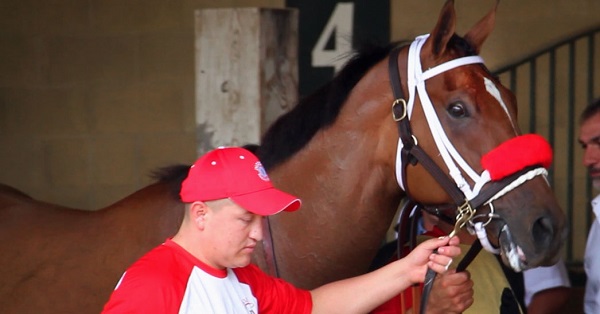BY JIM WELLS
The Belmont Stakes is the oldest and longest of the Triple Crown races and is run on the largest racing oval in the United States. It is the last of the three classics, sometimes showered in attention and anticipation, other times just another famous race, the last of the classics for the 3-year-olds of a given year.
It is the test of champions.
Ruthless won the first running of the Belmont Stakes in 1867 and in the years since the race has been ran at various distances, including 1 5/8 mile, 1 ¼ mile, 1 1/8, 1 3/8 and since 1926 at 1 ½.
A field of 12 will line up for the 149th running today, with Irish War Cry a slight favorite in an otherwise wide open race comprising a field of 12.
The Belmont Stakes does not have the fan devotion given the Kentucky Derby and is often dependent on a Triple Crown bid to attract the attention annually devoted to the first Saturday in May in Louisville, Ky.
The Derby itself is a national sports phenomenon, but the Belmont needs a horse that has won that race and the Preakness Stakes to grab anything approaching equal fanfare not to mention the national spotlight.
Certainly, we are excluding the died-in-the-wool racing fan in this analysis in an attempt to make a point about the reverence given the two races by the average and even above average sports fan.
Yet, the Belmont Stakes is unmatched in certain comparisons.
Belmont Park casts a huge shadow over other racetracks in the nation with its enormity; its size dwarfs other racing venues. Strategy differs here.
A mile and a half over the largest racing surface in the United States presents ample opportunity to make up for early minor mistakes, for making up lost ground in the early stages. There is no need to rush for position early.
But there is another factor that jockeys need to remember as they handicap the opposition and absorb trainers’ pre-race advice The imposing size, the sweeping final turn and the long stretch drive of this racing oval, the largest in the U.S., demand attention to detail. Belmont is no place for hair triggers, for impulsive decisions and can sap the overly eager during the grueling stretch drive.
The stories are legend of horses whose Triple Crown bids were destroyed here, sometimes due to a rider’s misjudging the distance left and moving too early, or a jockey who loses a sense of just how large this track is, who forgets that the home stretch is 1,097 feet long. The track is sandy and often deep and tiring. A rider needs to take all of that into account.
Canterbury Park Hall of Fame rider Scott Stevens rode Broadway Empire for trainer Robertino Diodoro in the 2014 Metropolitan Handicap, a preliminary to the Belmont Stakes, and recalls vividly his impressions of the behemoth.
“The crowd was unbelievable. I’ve never seen so many people,” he recalled.
More vividly he recalls the advice he heard repeatedly.
“People kept telling me before hand that when I thought I needed to move to wait another eighth of a mile,” he said. “They told me that over and over again. That turn is so big and the stretch is so long.”
Riders unaccustomed to Belmont’s imposing dimensions are sometimes prone to error. “A lot of riders have moved too soon. Take Real Quiet that year, he got caught,” Stevens added.
There is a familial tie for Stevens to that 1998 Belmont Stakes race. His brother, Gary, was on Victory Gallop, who caught a tiring Real Quiet in the final strides, denying him the Triple Crown by the smallest margin ever, a nose. No horse has lost a Triple Crown by less. Kent Desormeaux started moving his mount with five furlongs to go and paid for it by not more than an inch.
Diodoro has 31 horses at Belmont this summer and describes its enormity this way: “You need binoculars from the backside to see the horses,” he said. “They look like ants. It’s definitely huge. You can get caught moving too soon.”
Take that into consideration when analyzing the 2017 field. How familiar are the riders with Belmont. How many races have they ridden here. Experience counts on this enormous track.
DIODORO HORSE IN METROPOLITAN HANDICAP
Diodoro has been here before, with Broadway Empire, who finished sixth in 2014. He is back, this time with 31 horses, including Inside Straight, winner his last time out, on April 17, of the Grade II Oaklawn Handicap. Geovanni Franco, the usual rider, is injured and has been replaced for this race by Angel Arroyo.
A 15-1 morning line selection in this $1.2 million race at a mile, Inside Straight “has been training great and is coming off that Oaklawn win for two in a row,” Diodoro said. “He has a big heart and you couldn’t ask for a horse to do more. It’s a wide open race and we’ll see what happens.”
